The Rangers can’t buy a goal, and it’s been a thorn in everyone’s side since the season began. With just 16 goals in 8 games and 10 of those goals coming in just 2 games, the Rangers scoring woes are becoming a major problem that will stop this team dead in its tracks. The defensive process is much improved and the Rangers are a better product on the ice, but they won’t win by scoring one goal a game. The Rangers scoring woes are driven by far more than just a shooting drought, so a solution isn’t necessarily coming any time soon.
Shooting luck is just one factor
As a team, the Rangers scoring woes are rooted in three key areas: Shooting luck, roster construction, and individual shot location. Luck is the one that the team can’t necessarily control, but will eventually even out to career averages.
Focusing on the key scorers: Mika Zibanejad, Artemi Panarin, Alexis Lafreniere, Vincent Trocheck, and JT Miller, only Miller and Panarin are shooting over 10% (10% and 10.5%, respectively). Zibanejad (6.5%), Lafreniere (4.5%), and Trocheck (0% – injured) round out the top scoring players. Trocheck notwithstanding, all of the Rangers key scorers are well under their career shooting percentages.
Shooting luck is one key input into the Rangers scoring woes, but listing out SH% without context doesn’t help anyone. Panarin, for example, is a career 14.7% shooter, so he’s well under his mark. Same goes for Miller (15.2%), Zibanejad (13.2%), and Lafreniere (13.2%).
The Rangers will only go as far as their key scorers take them, especially with limited scoring depth. The good news is that simple math tells us this quartet–and Trocheck–will go on a heater at some point. The bad news is the Rangers scoring woes are forever tied to them, given the current roster construction.
Roster construction is a major factor in the Rangers scoring woes
As many have pointed out, the Rangers scoring woes are directly tied to the current roster construction. The current third line is a mess, which certainly plays into this. Noah Laba is essentially lost out there playing with Juuso Parssinen and Taylor Raddysh. Though both Parssinen and Raddysh have a goal apiece, there has been little else to show us this line is more than just a filler line.
The Rangers scoring depth was absolutely gutted, losing key contributors up and down the lineup. No one has stepped up to fill Chris Kreider’s shoes. Laba has, at least on paper, filled that young 3C role that Filip Chytil vacated, but without a proper line and role, he’s stuck in purgatory. But it goes beyond the forwards.
Reilly Smith’s production hasn’t been replaced. K’Andre Miller’s puck moving ability on the blue line hasn’t been replaced. Will Cuylle is off to a slow start and looks like he’s struggling to adjust to his new role in the new system. Cuylle will eventually be fine, but it does feel like he’s better off as a middle-six winger and not a top line winger. But there is currently no one to replace him in the top-six, contributing to the Rangers scoring woes.
The Rangers need three things to address their construction concerns: Another puck moving defenseman to help transition play, another scorer in the top six, and a third line that actually fills a role and can score.
Shot locations are a mess
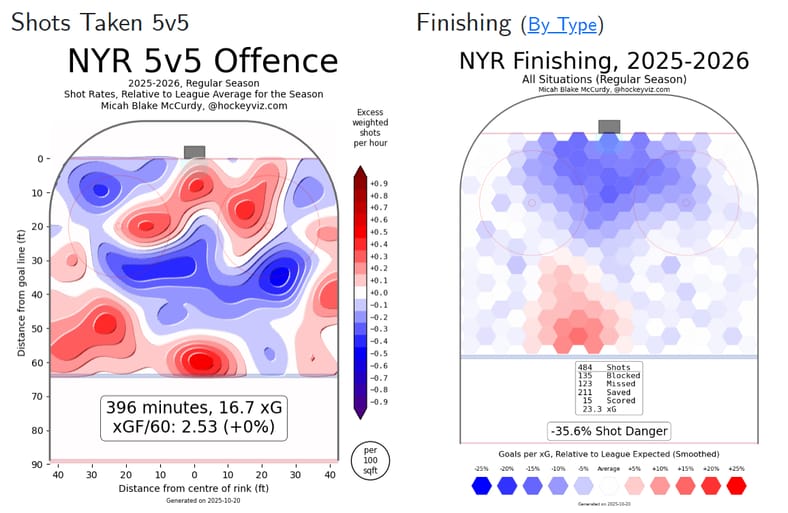
As a team, the Rangers scoring woes are pretty clearly focused on finishing in the high danger areas. The right most chart from Hockeyviz highlights this, as the Rangers are well below league average in finishing from the front of the net. They have 15 goals on a 23.3 xG this season (all situations), with their “hot” finishing coming from the mid-point. Not an ideal scenario.
Team shot locations aren’t too bad, but that sea of blue in the medium danger areas at the tops of the circles and high slot are a bit alarming. In theory, the Rangers are generating decent chances at the net mouth, and if you combine this with being snakebitten, then there’s cause for optimism. The Rangers scoring woes, in this scenario, would largely be tied to the shooting percentage. Unfortunately, there’s more to it.
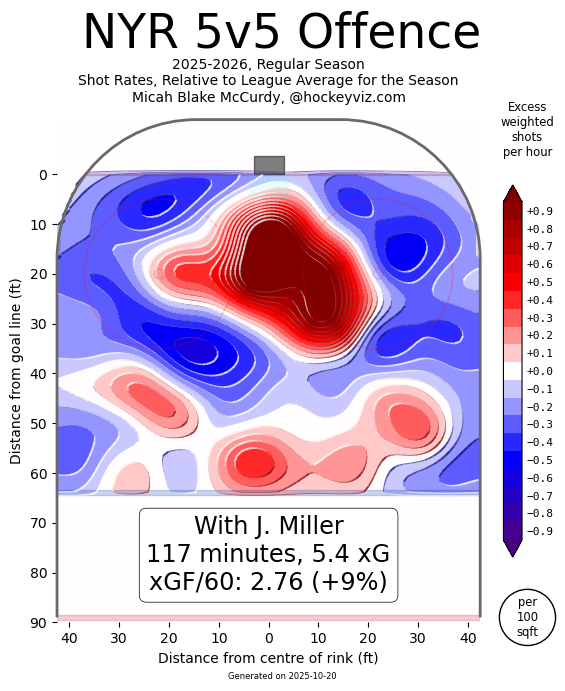
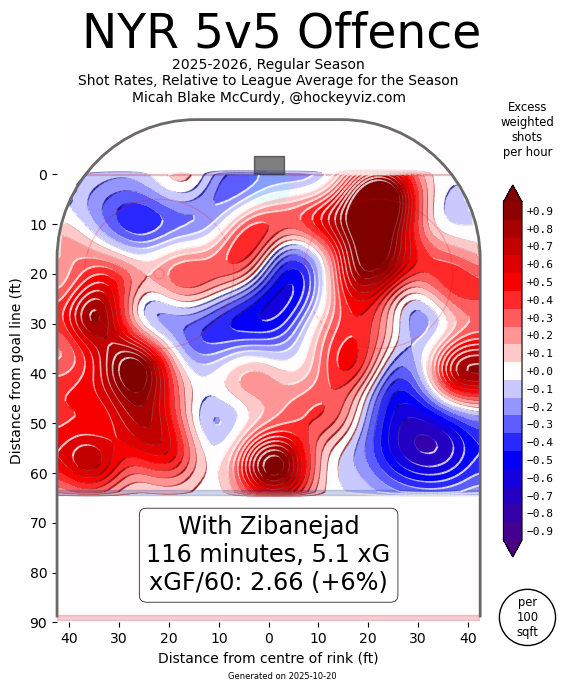
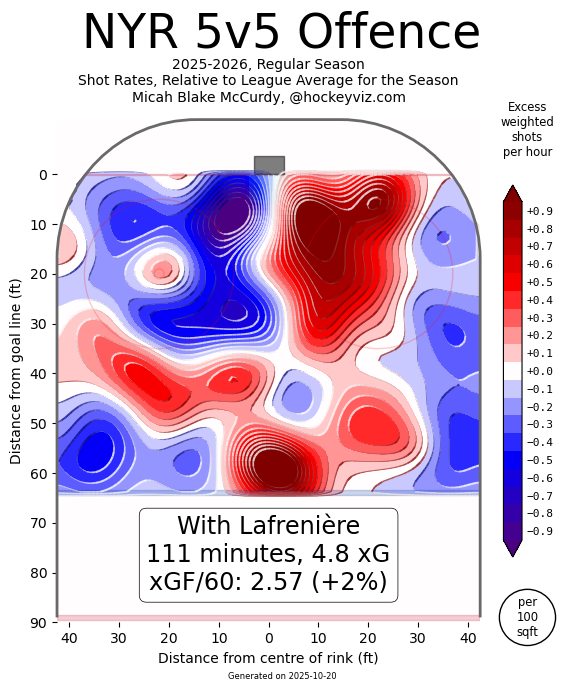
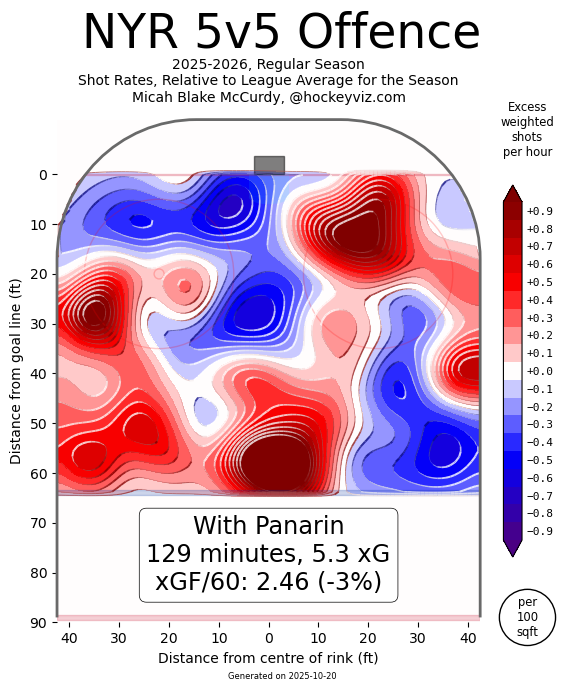
Focusing on the positive, it does appear that both Miller and Zibanejad are simply snakebitten. They are generating offense from high danger areas, but simply unable to convert consistently. Zibanejad in particular has looked like a man on a mission an dis completely rejuvenated. He’s been the Rangers best forward, bar none. The Rangers scoring woes with this duo may simply be due to SH% regression. This duo, should this play continue, will get back on track.
As an aside, Miller and Zibanejad routinely draw top competition. This may impact their finishing rates with stronger defensively play in front of them, but it’s anecdotal and it’s exceedingly difficult to prove that.
The Rangers shooting woes are particularly concerning when looking at both Panarin and Lafreniere. That’s a lot of blue in high danger areas, signaling that the Rangers scoring woes are tied to perimeter play when they are on the ice. Neither Laf nor Panarin have been net front guys, usually ceding that work to Trocheck. If this is what the Rangers are going to do with both of them on the ice, then they need a hard nosed center to draw attention away from them.
Both Panarin and Lafreniere are dangerous players and they will both eventually get going. It will be far more painful than we expect, though, as we wait for Trocheck to return.
The Rangers will only go as far as their current top-four (five when Trocheck is back) scorers take them. Hopefully the Rangers scoring woes correct themselves via shooting regression, but there’s more to it than simple poor luck.
More About: Analysis
